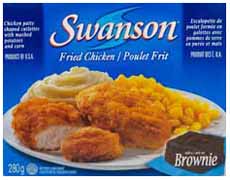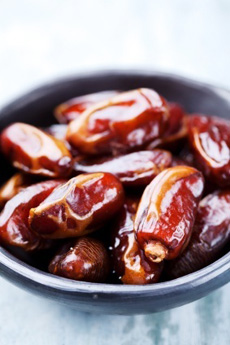|
Since we spend our days (and nights) tasting artisan food products, we don’t eat many frozen dinners.
But in grade school, they were a favorite meal. It was an easy way for our working mother to serve us a dinner of turkey, mashed potatoes and peas—and three slices of apple “cobbler” for dessert. There were other varieties—Fried Chicken, Salisbury Steak and—but we only wanted the turkey.
The novelty of eating food from the separate tray compartments was greater than our childhood awareness of how fine our mother’s home cooking was. So on days when she was headed out for the evening, we happily ate TV Dinners.
Long before the advent of microwaved food, millions of Americans ate them regularly. The name TV Brand Frozen Dinner is the registered trademark of C.A. Swanson & Sons, which introduced the frozen meals in 1953. They weren’t the first to sell frozen meals, but they were the first nationally successful brand.*
THE HISTORY OF TV DINNERS
Clarence Birdseye developed a process of flash-freezing food in in 1923. It would become a game-changer; but many American homes did not have refrigerator-freezers until after World War II.
Refrigerator-freezers had been introduced in 1939, but their availability was delayed by the the war (by 1944, nearly 70% of American homes had refrigerators).
The progenitor of the TV dinner was a frozen meal invented for airline use. The first frozen, ready-to-heat-and-eat meals appeared in 1941, created by Maxson Food Systems. Called “Strato-Plates.” The base was a plastic plate, divided into three separate compartments, that held portions of meat, potato and vegetable.
Alas, it did not then cross over to grocery stores, because of financial troubles within the company [source].
In the late 1940s, a company called FridgiDinners that sold a variation to bars and taverns that wanted an easy way to provide food. But the concept didn’t explode into consumer retail.
In 1949, Frozen Dinners Inc. of Pittsburgh, sold frozen meals, in three-compartment aluminum trays, which caught on in a big way. By 1952 the company expanded their sales area to the east coast. But they were not sold as meals to be eaten in front of the TV.
Swanson’s TV Dinners, the big brand in the category, were introduced in 1954, as television set sales were skyrocketing.
|
|

[1] Fried chicken TV Dinner (photo courtesy Wikimedia).

[2] Swanson marketed the first national frozen TV dinner brand (photo courtesy Wikimedia).

[3] The evolution of the TV Dinner, now a microwaveable “frozen meal” (photo © Denzil Green | Cook’s Info).
|
Thanks to war-related technological advances, the expansion of television networks, and the drop in prices from mass production, led to the television set replacing the radio as the source for entertainment and news in middle-class homes.
In the early 1950s, television blossomed as a news and entertainment medium. The “TV tray’ collapsible table made it easy for families to eat dinner in the living room, where the television resided in a large wood cabinet.
As the tale is told, Swanson got into the business as a way to use the vast surplus of Thanksgiving turkey. An executive allegedly came up with the name “TV dinner.” The first variety contained traditional Thanksgiving dinner ingredients: sweet potatoes, turkey with cornbread dressing, and peas. It sold for 89 cents and took about 25 minutes to heat in the oven.
Swanson trademarked the term “TV Dinner.” Along with a national advertising campaign, the brand exploded in popularity. TV dinners became a must-have for busy families, bachelors and others who didn’t like to (or couldn’t) cook.
Other manufacturers still made frozen meals, but Swanson’s TV Dinners were king.
In 1960, Swanson added a dessert compartment (a small brownie or cinnamon-apple slices, for example).
THE TV DINNER TODAY
What happened to the TV Dinner?
The adoption of microwave ovens required the replacement of the aluminum trays with plastic trays. Swanson’s microwave-safe plate appeared in 1986.
With more companies entering the microwavable meal business, the category was renamed (“microwave meals”).
Over time, as the product became more than a meal to eat while watching TV, the category became known as frozen meals; and later, adapted for microwave meals. The aluminum trays were ditched for the microwave and microwaveable plastic.
In 1987, a Swanson TV dinner with the original aluminum tray (and plastic food recreating the original) was added to the collection of the Smithsonian Museum.
_______________
* The first variety was turkey, peas and sweet potatoes with cornbread dressing.
|





